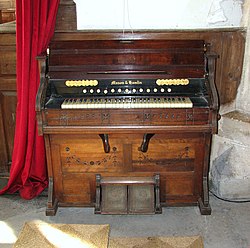Harmonium
A harmonium, also called a "reed organ" or "pump organ", is a keyboard instrument that is a lot like an organ. It makes sound by blowing air through reeds, which are tuned to different pitches to make musical notes.
A harmonium can be made to work using either the feet or the hands:
- In a foot-pumped harmonium, the player presses two pedals with their feet, one at a time. This is joined to a mechanism which operates a bellows, sending air to the reeds. Both of the player's hands are free to play the keyboard. This type was invented in 1842 by Alexandre Debain of Paris, although similar instruments have been made in other places around the same time.
- In a hand-pumped harmonium, the player pushes and pulls a handle back and forth with one hand, which is joined to the bellows that blows the air. Because of this, they can only use one hand to play the keys as the other has to keep pumping the bellows. Some players can pump enough air with one hand, and then play the keys with both hands, when necessary.
The hand-pumped harmonium was created by Dwarkanath Ghose so that the instrument could be played while the player was sitting down on the floor. It is used in Afghanistan, Bangladesh, India, Nepal, Pakistan, and in other South Asian countries as an accompanying instrument in Hindustani classical music, Sufi Music, Bhajan and other devotional music, Qawwali, Natya Sangeet, and a variety of genres including accompaniment to Classical Kathak Dance and other entertainments. Others began building used similar instruments. In Vienna, Anton Haeckl constructed the physharmonica, a keyboard instrument filled with free reeds. John Green invented the seraphine, which produced music when air was blown over metallic reeds. Such instruments are now museum pieces.
The first instrument called a harmonium was made by Alexandre Debain in 1840 in France. He patented his harmonium in Paris on August 9, 1840.
A Harmonium with a swarmandal (a small, harp-like instrument, similar to a Zither or an Autoharp) was made by Bhishmadev Vedi. As the swarmandal box was too big for the harmonium, his disciple Manohar Chimote fixed the strings within the breadth of the instrument naming it as ‘Samvadini’. This instrument allows the strings to be played by the hand on the bellows, and keys by the other hand. Chimote provided a new natural ‘Gandhar’ tuning in this harmonium. Although this tuning was limited to the 12 tones versus the 22 required in Hindustani classical music.
A 22-Shruti-Harmonium was created by Vidyadhar Oke (Indian Patent No. 250197). To achieve this, he first clarified the essential difference between 'Nada' and 'Shruti' and pinpointed the positions to play the 22 Microtones (Shrutis) on any string instrument. He documented the specific difference between 22 Shrutis versus the 12-Tone Equal temperament Scale. His 22-Shruti-Harmonium provides special knobs below each of the keys to regulate the reeds, making 22 Shrutis available within 12 keys. As this is a modified hand-pumped harmonium, no special playing skill is necessary. The 22-Shruti-Harmonium enables the creation of any Raga with all the notes perfectly consonant with a Tanpura. By positioning all the knobs in the central position, the 22-Shruti-Harmonium can produce the sound of an accordion.
A Shruti box is a keyless harmonium, used only to produce drones to support other soloists.[1]
Harmonium Media
A hand-pumped Indian harmonium, of the type used in South Asia, here used at a European jazz festival.
Modern Indian harmonium with nine air stop knobs (stops 2, 4, 6, 8 are drones).
A Mason & Hamlin pump organ
References
- ↑ "Harmonium - India Instruments". www.india-instruments.com. Retrieved 2023-12-13.
| Wikimedia Commons has media related to Lua error in Module:Commons_link at line 62: attempt to index field 'wikibase' (a nil value).. |
- Western free reed instruments
- The New Grove Dictionary of Music and Musicians. Harmonium. ISBN 1-56159-229-3
- Shrutigeeta. Vidyadhar Oke. Madhav Rafter Publications. 2011. ISBN 978-81-922379-2-3
- Shrutividnyan Va Ragasoundarya. Vidyadhar Oke, Sadashiv Bakre. Rajhansa Prakashan. 2015. ISBN 978-81-7434-853-1
- Difference between Nada and Shruti
- Precice positions of 22 Shrutis
- Accordian played on 22 Shruti Harmonium
- Placement of 22 Shrutis in a Harmonium
- Dr.Vidyadhar Oke 22 shruti harmonium












